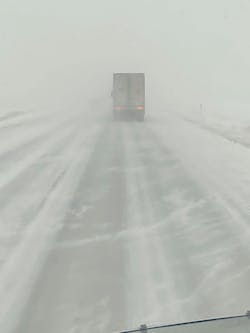Key Highlights
- Winter driving can be hard on trucks and dangerous for drivers, so fleets should begin theri winterization process as soon as possible.
- A few key systems to inspect and/or replace include truck batteries, the air system, tires, and the fuel system.
- Meanwhile, drivers should make sure they have proper emergency kits and cold-weather gear on hand, including warm jackets and mittens and non-perishable food. A mattress heater can also be great for winter.
A poem by Robert W. Service, “The Cremation of Sam McGee,” tells the tale of a hapless chap from Tennessee, "where cotton blooms and blows." McGee tries to hustle the northern region during the Klondike gold rush, but learns the hard way that his winters from home have nothing on the Yukon and freezes to death. If poor Sam McGee had been better prepared for his trip, as fleet trucks must often be when they hit the road, he might have escaped his fiery fate.
While cold weather isn't inherently as hard on equipment as it is on a human, it will expose pre-existing weaknesses such as sketchy batteries, slobbery compressors, and contaminated fuel. So, winter preparations should include thorough inspections of a few critical systems on the truck, as well as assembling a driver's winter-survival kit.
With this in mind, now is the time to get a jump on old man winter by inspecting the following systems.
Starting/charging system
To ensure that every amp the battery produces gets to the starter, the terminal posts and cables need to be cleaned and inspected. All connections at the starter, alternator, engine block, and frame should be free of corrosion, properly secured, insulated, and free of wear and damage. Replace all questionable cables and wire ends — no questions asked.
Next, have your batteries load-tested and check alternator outputs as well as starter draw. After all, going into winter with weak batteries isn't worth the risk. For example, at 32 degrees F, a lead-acid battery may deliver only about 80% of its rated capacity. At 0 degrees F, this can drop to 50% or less. Cold temperatures also reduce a battery's ability to accept a charge from the alternator, while extra demand on the batteries (heater and defroster fans, heated seats, headlights, etc.) draws them down faster. So once you’ve tested your batteries, be sure to replace the weak one before it kills the rest of the pack.
Air system
Compressed air used for braking, transmission function, and even the emissions system needs to be dry and free of contaminants such as oily sludge from a worn-out compressor. Air driers and filters work well when properly maintained, but it shouldn't be assumed the air dryer is catching all the moisture in the system. If there's excessive moisture in the "wet" air tank, it's already been through the air dryer.
Water isn't a big problem if it stays wet, but during winter, it can be a real headache when it freezes, especially if it solidifies in one of those tiny channels inside some brake valves.
I once had a glob of oily compressor sludge mix with ice crystals from moisture in the compressed air. It completely blocked the discharge hose from my air dryer. After replacing the compressor and the air drier desiccant cartridge, I switched from the cable-release drain cocks to the twist-open type. These let you open them up completely and walk away, rather than holding them open, ensuring the tanks drain completely and avoiding a similar issue.
If a similar incident happens on the road, drivers' options are limited. But if the air system does freeze up, a dose of air brake antifreeze (methyl hydrate) usually solves the problem. Also, if you put a bottle on the truck, include instructions on how to use it.
Fuel system
Your pre-winter fuel system maintenance starts by draining a little fuel from the tanks. With it will come the water that has accumulated over the summer, along with any other contaminants you've pumped into your tanks. Even if you're careful about where you buy fuel, water will accumulate in the fuel tank from the condensation that forms on the cold, bare metal after shut-down in winter.
It won't hurt to replace the fuel filters now, too. Water collects at the bottom of the filters and can freeze while the engine is off. Consider equipping your trucks with spare fuel and a filter wrench, along with instructions on how to change a fuel filter.
Tire tread and pressure
Fuel economy is always a concern, but in winter, it might take a back seat to traction. It’s recommended that tread not be run below 8/32nds when the snow starts flying. If you run rib tires, you also might want to consider switching to a set of partially worn lug tires for the season.
Tire inflation is impacted by low ambient temperatures. Inflation pressures fall about one psi for every 10-degree F drop in temperature. If your tires are 100 psi in Phoenix when it's 80 degrees, they will be severely underinflated in North Dakota in February. It's a big ask of drivers, but inflation checks are important when traveling between radically different climates.
Keep the driver warm
Fleets might want to think about a cold-weather primer for drivers not familiar with unforgiving temperatures. Breakdowns, especially those where the engine no longer works (perhaps due to gelled fuel or being run off the road), pose significant risks for frostbite and hypothermia without suitable precautions.
Since severe weather can inhibit travel, drivers should be warned to travel in groups and never venture onto closed roads. Travel on remote roads carries its own set of risks.
As for equipment to help drivers stay warm, diesel-powered auxiliary power units are the best option for winter ops, followed closely by diesel-fired cab heaters. The APU obviously has the advantage of keeping the engine warm and the batteries charged while powering hotel loads, while the heaters merely keep the cab warm. But with costs and maintenance concerns, the heaters are probably the more practical option.
While you’re at it, now is a good time to service those, too.
Finally, back in the mid-1980s, I came across what I believe might be the most useful device ever invented for the over-the-road driver: the 12-volt mattress pad heater. Bar none, that mattress pad saved me more money than any other gizmo I had ever purchased. For a mere 50 bucks (Amazon still sells these), I could shut off the engine to well below zero and stay toasty and warm under a thick comforter all night.
In all the years I used a mattress pad heater, I never once woke up to dead batteries — but I checked them before the onset of winter.
Drivers' survival kit
I always carried a winter survival kit, so I was shocked to learn how many drivers do not. If you run the northern states or even into Canada, especially western Canada, it's foolhardy not to carry one. After all, I dug into mine many times over my 20-year driving career. Here’s a couple key items to keep in your emergency kit:
- Winter clothing (jacket, snow pants, hat, warm mittens): Much of this can be found at very reasonable prices at any northern thrift store, such as Goodwill.
- Non-perishable, non-freezable food such as energy bars and granola bars: Candy bars are a good energy source, too. Don't rely on food that needs to be heated, as your batteries might get critically low after a short time in the cold if the engine isn't running. And avoid canned food, as it usually contains water, which could freeze.
- Sources of heat such as cans of Sterno or gelled alcohol: Pack several large candles along with matches or a lighter.
- Basic tools, such as a shovel, are mandatory. Don't forget a filter wrench for replacing frozen fuel filters.
Also, include a written primer on the risk of frostbite (frozen skin tissue) and hypothermia (low body core temperature), illustrating symptoms and rough timeframes for exposure, along with tips on how to treat the conditions.
Basic temperatures and exposure time risks include:
- 0 degrees F: Frostbite risk after 30–60 minutes of exposure
- -15 degrees F: Frostbite risk in 10–15 minutes
- -40 degrees F: Frostbite risk in less than 5 minutes
- 40–50 degrees F: Hypothermia is possible within several hours
- 20–30 degrees F: Hypothermia risk in 30–90 minutes
- Less than 20 degrees F: Hypothermia can occur in under 30 minutes with poor clothing. Cut those times in half if clothing is wet.
Even with all of our current technology, winter still poses real risks to drivers and equipment. Road closures are frequent occurrences in the north, and once those gates close behind you, it could be a while before you see another truck. Make sure your drivers and equipment are prepared for when the snow sets in, so you don’t end up with a case like Sam McGee’s.
About the Author

Jim Park
Jim Park is an award-winning journalist who has covered the trucking industry since 1998. Prior to that, he racked up 2 million miles as a driver and owner-operator pulling tank trailers over-the-road. He continues to maintain his CLD.
Jim's previous driving experience brings a real-world perspective to his work. Jim's strong suits are equipment and technical matters, emerging technology, vehicle spec'ing, safety, and driver issues. He has hosted an overnight radio show for truckers, produced many technical and training videos, and has published three research papers on driver fatigue and the driver shortage. He has earned 9 Jesse H. Neal awards, including “Best Range of Work by a Single Author” in 2020.

